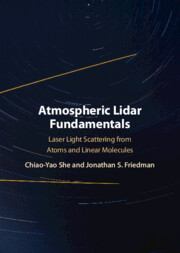Book contents
- Atmospheric Lidar Fundamentals
- Atmospheric Lidar Fundamentals
- Copyright page
- Dedication
- Contents
- Foreword
- Preface
- 1 Introduction
- 2 Classical Light Scattering Theory
- 3 Semiclassical Treatment of Light Absorption and Scattering from Atoms
- 4 Rayleigh and Raman Scattering from Linear Molecules
- 5 Introduction to Lidar Remote Sensing and the Lidar Equation
- 6 Common (Broadband) Lidar Types and Associated Applications
- 7 Lidars for Profiling Aerosol Optical Properties, Atmospheric Temperature and Wind
- 8 Transmitting and Receiving Optics
- Book part
- Index
- References
8 - Transmitting and Receiving Optics
Published online by Cambridge University Press: 24 February 2022
- Atmospheric Lidar Fundamentals
- Atmospheric Lidar Fundamentals
- Copyright page
- Dedication
- Contents
- Foreword
- Preface
- 1 Introduction
- 2 Classical Light Scattering Theory
- 3 Semiclassical Treatment of Light Absorption and Scattering from Atoms
- 4 Rayleigh and Raman Scattering from Linear Molecules
- 5 Introduction to Lidar Remote Sensing and the Lidar Equation
- 6 Common (Broadband) Lidar Types and Associated Applications
- 7 Lidars for Profiling Aerosol Optical Properties, Atmospheric Temperature and Wind
- 8 Transmitting and Receiving Optics
- Book part
- Index
- References
Summary
In Chapter 8, we give an overview of the optics that control beam transmission and signal reception. We open with a description of the use and benefits of a beam expander to control the output beam divergence. From there, we move to describing receiver optics, starting with the telescope and importance of size, field of view, and using high-quality optics. This includes using an optical fiber to transport the received photons to the downstream filtering and detection optics. Next, we discuss detector characteristics and the trade-offs one must consider when selecting an appropriate photon counting sensor. We follow with a short section on the value of computer modeling the receiver optics. We close the chapter with a concise discussion of atmospheric turbulence and of laser guide stars and adaptive optics for the mitigation of atmospheric turbulence effects on astronomical telescopes.
Keywords
- Type
- Chapter
- Information
- Atmospheric Lidar FundamentalsLaser Light Scattering from Atoms and Linear Molecules, pp. 244 - 267Publisher: Cambridge University PressPrint publication year: 2022

